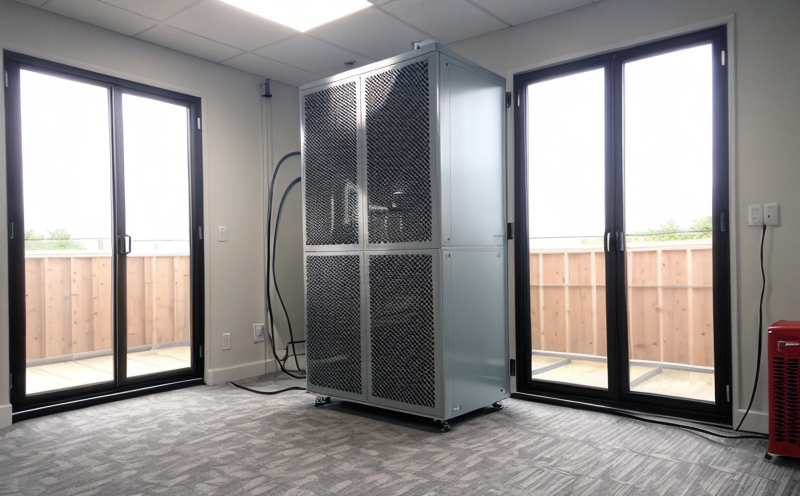BS EN 13779 Indoor Air Distribution Testing
The British Standard (BS) and European Norm (EN) 13779:2002 defines the method for testing indoor air distribution in HVAC systems. This standard is crucial for ensuring that air is uniformly distributed within a space, which directly impacts occupant comfort and health. Proper airflow ensures that contaminants are effectively removed from an enclosed environment while maintaining a consistent temperature and humidity level.
Indoor air quality (IAQ) is increasingly recognized as a key factor in enhancing productivity and employee well-being. Compliance with BS EN 13779 helps facilities meet regulatory requirements, improve energy efficiency, and reduce the risk of sick building syndrome. This testing method is particularly important for large commercial buildings, hospitals, schools, and other environments where maintaining air quality is paramount.
During a typical test under this standard, an HVAC system is operated to maintain steady-state conditions. The airflow through various points in the ventilation network is measured using standardized techniques. Instruments such as anemometers and pressure gauges are employed to ensure accuracy. These measurements are then compared against the design criteria outlined in the BS EN 13779 document.
One of the key aspects of this testing is the use of tracer gases, which allows for precise measurement of air movement within a building. Tracer gases like sulfur hexafluoride (SF6) are introduced into the system and their concentration is measured at various points to assess the mixing efficiency of the HVAC system. This helps in identifying any areas where airflow may be uneven or restricted.
The acceptance criteria for BS EN 13779 involve ensuring that all air outlets meet specified flow rates, pressures, and velocities. The standard also requires that there is sufficient mixing to ensure that the air quality remains consistent across the entire space. Failure to meet these criteria can lead to discomfort, poor health outcomes, and potential safety hazards.
Our laboratory adheres strictly to this standard, ensuring accurate and reliable testing results. Our team of experts uses cutting-edge instrumentation and follows precise protocols to guarantee compliance with industry standards. This commitment to accuracy is crucial for facilities that rely on HVAC systems for maintaining optimal indoor environments.
The importance of air distribution cannot be overstated in modern buildings. With the increasing focus on sustainable design and energy efficiency, proper airflow plays a critical role in reducing energy consumption while enhancing occupant satisfaction. Our testing services not only help ensure compliance with industry standards but also provide valuable insights into system performance.
Benefits
Implementing BS EN 13779 Indoor Air Distribution Testing offers numerous benefits to organizations across various sectors. For quality managers, this testing ensures that the HVAC systems are operating efficiently and effectively, minimizing the risk of operational failures. Compliance officers can use these test results to verify that their facilities meet all relevant regulatory requirements.
R&D engineers benefit from detailed insights into system performance, which can be used to optimize design parameters for future projects. Procurement teams gain confidence in purchasing equipment that meets strict quality standards, leading to longer-lasting and more reliable systems. Ultimately, these tests contribute to improved air quality, enhanced occupant comfort, and reduced operational costs.
By adhering to this standard, organizations can also demonstrate their commitment to sustainability and environmental responsibility. This is particularly important in the context of growing public awareness about indoor air quality issues. Such actions can enhance an organization’s reputation and attract customers who prioritize these values.
Customer Impact and Satisfaction
The implementation of BS EN 13779 Indoor Air Distribution Testing has a direct impact on customer satisfaction by ensuring that the indoor air environment is healthy and comfortable. For employees, this means fewer sick days due to poor air quality, leading to increased productivity. For visitors or patients in healthcare facilities, it ensures a safe and pleasant experience.
From an operational perspective, organizations benefit from reduced energy costs as efficient airflow minimizes the need for excessive heating or cooling. This not only saves on utility bills but also contributes to a more environmentally friendly operation. The improved air quality can lead to better decision-making processes and enhanced creativity among employees.
Customer satisfaction is further enhanced by the peace of mind that comes from knowing that their environment meets high standards of hygiene and comfort. This is particularly important in hospitality, retail, and healthcare sectors where customer experience is a key differentiator. By providing services aligned with this standard, we help our clients achieve these benefits, thereby enhancing overall customer satisfaction.
Competitive Advantage and Market Impact
In today’s competitive market, organizations that prioritize indoor air quality can gain a significant advantage. Compliance with BS EN 13779 is not just about meeting regulatory requirements; it sets a benchmark for excellence in HVAC performance. This translates into higher customer satisfaction, which is crucial for building brand loyalty and attracting new clients.
From an operational standpoint, the efficiency gains from optimized airflow can reduce energy costs, contributing to improved profitability. Additionally, the ability to demonstrate commitment to sustainability can be a powerful differentiator in marketing efforts. Potential customers are increasingly seeking out businesses that prioritize environmental responsibility, making this standard a valuable tool for gaining market share.
The impact on employee well-being is another factor that contributes to competitive advantage. Healthy and comfortable work environments lead to higher job satisfaction and lower turnover rates. This can result in a more motivated workforce capable of delivering high-quality products or services. In turn, this translates into greater overall performance, which can enhance an organization’s reputation and market position.





